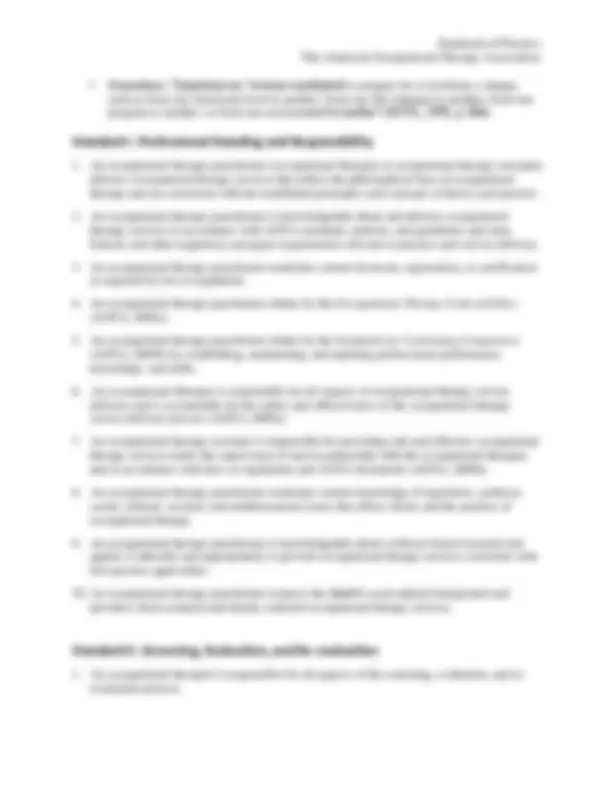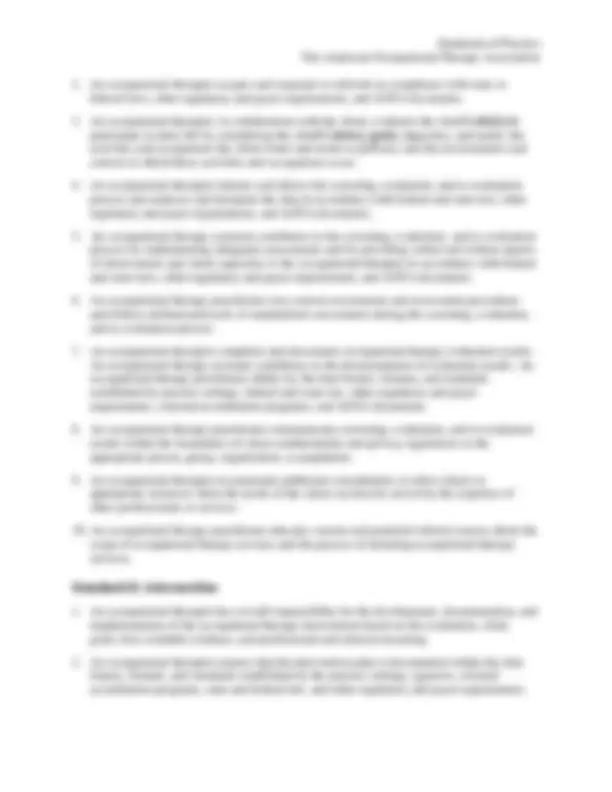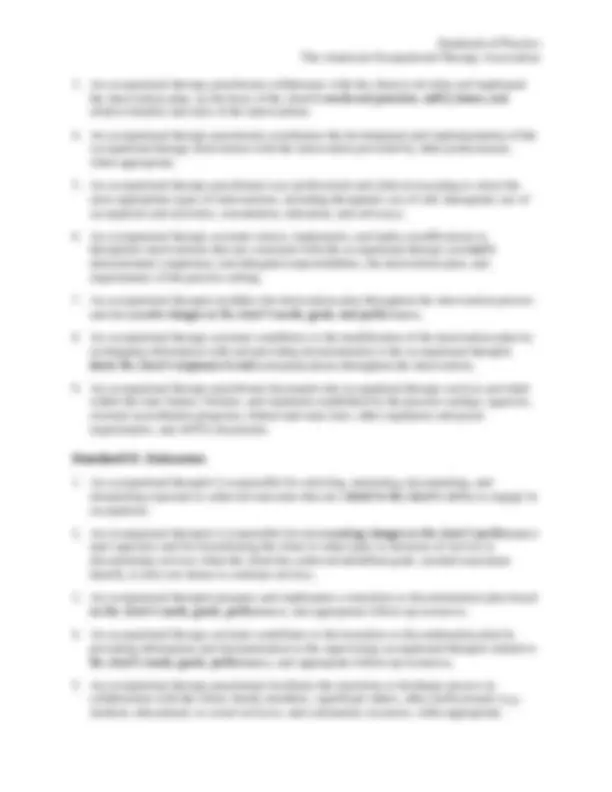Download Occupational Therapy Standards of Practice: Minimum Requirements for Delivery of Services and more Study notes Occupational therapy in PDF only on Docsity!
STANDARDS OF PRACTICE FOR OCCUPATIONAL THERAPY
This document defines minimum standards for the practice of occupational therapy. The practice of occupational therapy means the therapeutic use of everyday life activities (occupations) with individuals, groups, organizations, and populations for the purpose of participation in roles and situations in the home, school, workplace, community, or other settings. Occupational therapy services are provided for the purpose of promoting health and wellness and to those who have or are at risk for developing an illness, injury, disease, disorder, condition, impairment, disability, activity limitation, or participation restriction. Occupational therapy addresses physical, cognitive, psychosocial, sensory, communication, and other areas of performance in various contexts and environments in everyday life activities that affect health, well-being, and quality of life (American Occupational Therapy Association [AOTA], 2004). The overarching goal of occupational therapy is “to support [people’s] health and participation in life through engagement in occupations” (AOTAa, 2008, p. 626).
The Standards of Practice for Occupational Therapy are requirements for occupational therapists and occupational therapy assistants for the delivery of occupational therapy services. The Reference Manual of Official Documents of the American Occupational Therapy Association, Inc. (current version as of press time, AOTA, 2009b) contains documents that clarify and support occupational therapy practice, as do various issues of the American Journal of Occupational Therapy. These documents are reviewed and updated on an ongoing basis for their applicability.
Education, Examination, and Licensure Requirements
All occupational therapists and occupational therapy assistants must practice under federal and state law.
To practice as an occupational therapist, the individual trained in the United States
- Has graduated from an occupational therapy program accredited by the Accreditation Council for Occupational Therapy Education (ACOTE®) or predecessor organizations;
- Has successfully completed a period of supervised fieldwork experience required by the recognized educational institution where the applicant met the academic requirements of an educational program for occupational therapists that is accredited by ACOTE®^ or predecessor organizations;
- Has passed a nationally recognized entry-level examination for occupational therapists; and
- Fulfills state requirements for licensure, certification, or registration.
To practice as an occupational therapy assistant, the individual trained in the United States
- Has graduated from an occupational therapy assistant program accredited by ACOTE®^ or predecessor organizations;
The American Occupational Therapy Association
- Has successfully completed a period of supervised fieldwork experience required by the recognized educational institution where the applicant met the academic requirements of an educational program for occupational therapy assistants that is accredited by ACOTE®^ or predecessor organizations;
- Has passed a nationally recognized entry-level examination for occupational therapy assistants; and
- Fulfills state requirements for licensure, certification, or registration.
Definitions
The following definitions are used in this document:
- Activity (Activities) : A class of human behaviors that are goal directed.
- Assessment : Specific tools or instruments that are used during the evaluation process.
- Client : The entity that receives occupational therapy services. Clients may include (1) individuals and other persons relevant to the individual’s life, such as family, caregivers, teachers, employers, and others who also may help or be served indirectly; (2) organizations such as business, industry, or agencies; and (3) populations within a community (Moyers & Dale, 2007).
- Evaluation : The process of obtaining and interpreting data necessary for intervention. This includes planning for and documenting the evaluation process and results.
- Intervention : The process and skilled actions taken by occupational therapy practitioners in collaboration with the client to facilitate engagement in occupation related to health and participation. The intervention process includes the plan, implementation, and review.
- Occupation : “Goal-directed pursuits that typically extend over time, have meaning to their performance, and involve multiple tasks” (Christiansen, Baum, & Bass-Haugen, 2005, p. 548); “all the things that people want, need, or have to do, whether of a physical, mental, social, sexual, political, spiritual, or any other nature, including sleep and rest activities.” (Wilcock & Townsend, 2009, p. 193); “activities of everyday life named, organized, and given meaning by individuals and a culture” (Law, Polatajko, Baptiste, & Townsend, 1997, p. 32).
- Outcomes: What occupational therapy actually achieves for the client. Changes desired by the client that can focus on any area of the client’s occupational performance.
- Re-evaluation: The process of critical analysis of client response to intervention. This analysis enables the therapist to make any necessary changes to intervention plan in collaboration with the client.
- Screening: Obtaining and reviewing data relevant to a potential client to determine the need for further evaluation and intervention.
The American Occupational Therapy Association
- An occupational therapist accepts and responds to referrals in compliance with state or federal laws, other regulatory and payer requirements, and AOTA documents.
- An occupational therapist, in collaboration with the client, evaluates the client’s ability to participate in daily life by considering the client’s history, goals, capacities, and needs; the activities and occupations the client wants and needs to perform; and the environments and context in which these activities and occupations occur.
- An occupational therapist initiates and directs the screening, evaluation, and re-evaluation process and analyzes and interprets the data in accordance with federal and state law, other regulatory and payer requirements, and AOTA documents.
- An occupational therapy assistant contributes to the screening, evaluation, and re-evaluation process by implementing delegated assessments and by providing verbal and written reports of observations and client capacities to the occupational therapist in accordance with federal and state laws, other regulatory and payer requirements, and AOTA documents.
- An occupational therapy practitioner uses current assessments and assessment procedures and follows defined protocols of standardized assessments during the screening, evaluation, and re-evaluation process.
- An occupational therapist completes and documents occupational therapy evaluation results. An occupational therapy assistant contributes to the documentation of evaluation results. An occupational therapy practitioner abides by the time frames, formats, and standards established by practice settings, federal and state law, other regulatory and payer requirements, external accreditation programs, and AOTA documents.
- An occupational therapy practitioner communicates screening, evaluation, and re-evaluation results within the boundaries of client confidentiality and privacy regulations to the appropriate person, group, organization, or population.
- An occupational therapist recommends additional consultations or refers clients to appropriate resources when the needs of the client can best be served by the expertise of other professionals or services.
- An occupational therapy practitioner educates current and potential referral sources about the scope of occupational therapy services and the process of initiating occupational therapy services.
Standard III. Intervention
- An occupational therapist has overall responsibility for the development, documentation, and implementation of the occupational therapy intervention based on the evaluation, client goals, best available evidence, and professional and clinical reasoning.
- An occupational therapist ensures that the intervention plan is documented within the time frames, formats, and standards established by the practice settings, agencies, external accreditation programs, state and federal law, and other regulatory and payer requirements.
The American Occupational Therapy Association
- An occupational therapy practitioner collaborates with the client to develop and implement the intervention plan, on the basis of the client’s needs and priorities, safety issues, and relative benefits and risks of the interventions.
- An occupational therapy practitioner coordinates the development and implementation of the occupational therapy intervention with the intervention provided by other professionals, when appropriate.
- An occupational therapy practitioner uses professional and clinical reasoning to select the most appropriate types of interventions, including therapeutic use of self, therapeutic use of occupations and activities, consultation, education, and advocacy.
- An occupational therapy assistant selects, implements, and makes modifications to therapeutic interventions that are consistent with the occupational therapy assistant’s demonstrated competency and delegated responsibilities, the intervention plan, and requirements of the practice setting.
- An occupational therapist modifies the intervention plan throughout the intervention process and documents changes in the client’s needs, goals, and performance.
- An occupational therapy assistant contributes to the modification of the intervention plan by exchanging information with and providing documentation to the occupational therapist about the client’s responses to and communications throughout the intervention.
- An occupational therapy practitioner documents the occupational therapy services provided within the time frames, formats, and standards established by the practice settings, agencies, external accreditation programs, federal and state laws, other regulatory and payer requirements, and AOTA documents.
Standard IV. Outcomes
- An occupational therapist is responsible for selecting, measuring, documenting, and interpreting expected or achieved outcomes that are related to the client’s ability to engage in occupations.
- An occupational therapist is responsible for documenting changes in the client’s performance and capacities and for transitioning the client to other types or intensity of service or discontinuing services when the client has achieved identified goals, reached maximum benefit, or does not desire to continue services.
- An occupational therapist prepares and implements a transition or discontinuation plan based on the client’s needs, goals, performance, and appropriate follow-up resources.
- An occupational therapy assistant contributes to the transition or discontinuation plan by providing information and documentation to the supervising occupational therapist related to the client’s needs, goals, performance, and appropriate follow-up resources.
- An occupational therapy practitioner facilitates the transition or discharge process in collaboration with the client, family members, significant others, other professionals (e.g., medical, educational, or social services), and community resources, when appropriate.
The American Occupational Therapy Association
Authors
The Commission on Practice: Janet V. DeLany, DEd, OTR/L, FAOTA, Chairperson Debbie Amini, MEd, OTR/L, CHT Ellen Cohn, ScD, OTR/L, FAOTA Jennifer Cruz, MAT, MOTS, ASD Liaison Kimberly Hartmann, PhD, OTR/L, FAOTA, SISC Liaison Jeanette Justice, COTA/L Kathleen Kannenberg, MA, OTR/L, CCM Cherylin Lew, OTD, OTR/L James Marc-Aurele, MBA, OTR/L Mary Jane Youngstrom, MS, OTR, FAOTA Deborah Lieberman, MHSA, OTR/L, FAOTA, AOTA Headquarters Liaison
for
The Commission on Practice Janet V. DeLany, DEd, OTR/L, FAOTA, Chairperson
The COP wishes to acknowledge the authors of the 2005 edition of this document: Sara Jane Brayman, PhD, OTR/L, FAOTA, Chairperson; Susanne Smith Roley, MS, OTR/L, FAOTA, Chairperson-Elect; Gloria Frolek Clark, MS, OTR/L, FAOTA; Janet V. DeLany, DEd, MSA, OTR/L, FAOTA; Eileen R. Garza, PhD, OTR, ATP; Mary V. Radomski, MA, OTR/L, FAOTA; Ruth Ramsey, MS, OTR/L; Carol Siebert, MS, OTR/L; Kristi Voelkerding, BS, COTA/L; Lenna Aird, COTA/L, ASD Liaison; Patricia D. LaVesser, PhD, OTR/L, SIS Liaison; and Deborah Lieberman, MHSA, OTR/L, FAOTA, AOTA Headquarters Liaison.
Adopted by the Representative Assembly Coordinating Council (RACC) for the Representative Assembly
Revised by the Commission on Practice 2010
This revision replaces the 2005 document Standards of Practice for Occupational Therapy (previously published and copyrighted in 2005 by the American Occupational Therapy Association in the American Journal of Occupational Therapy, 59, 663 – 665).
To be published and copyrighted in 2010 by the American Occupational Therapy Association in the American Journal of Occupational Therapy , 64 (November/December).
Note. These standards are intended as recommended guidelines to assist occupational therapy practitioners in the provision of occupational therapy services. These standards serve as a minimum standard for occupational therapy practice and are applicable to all individual populations and the programs in which these individuals are served.














